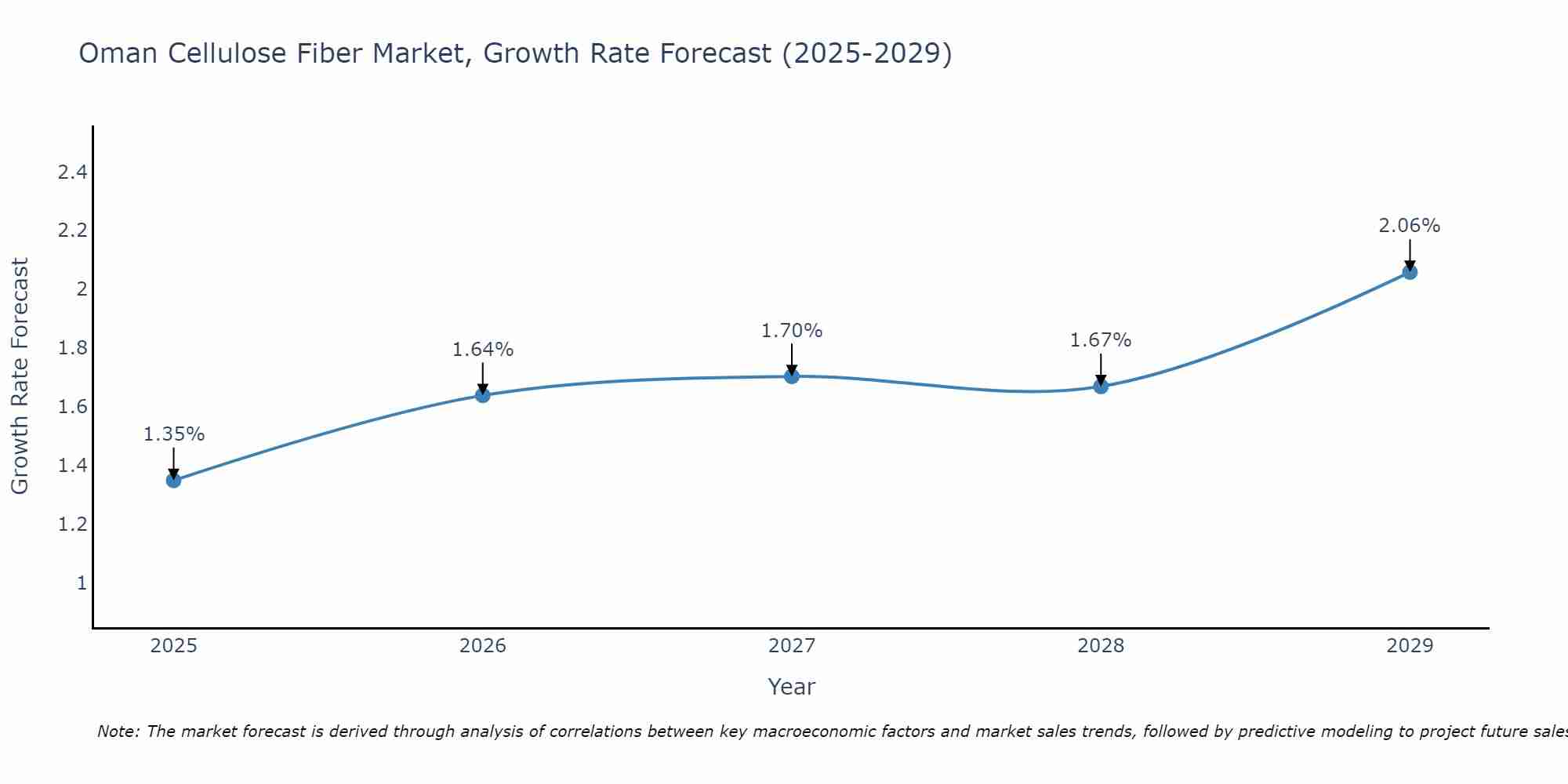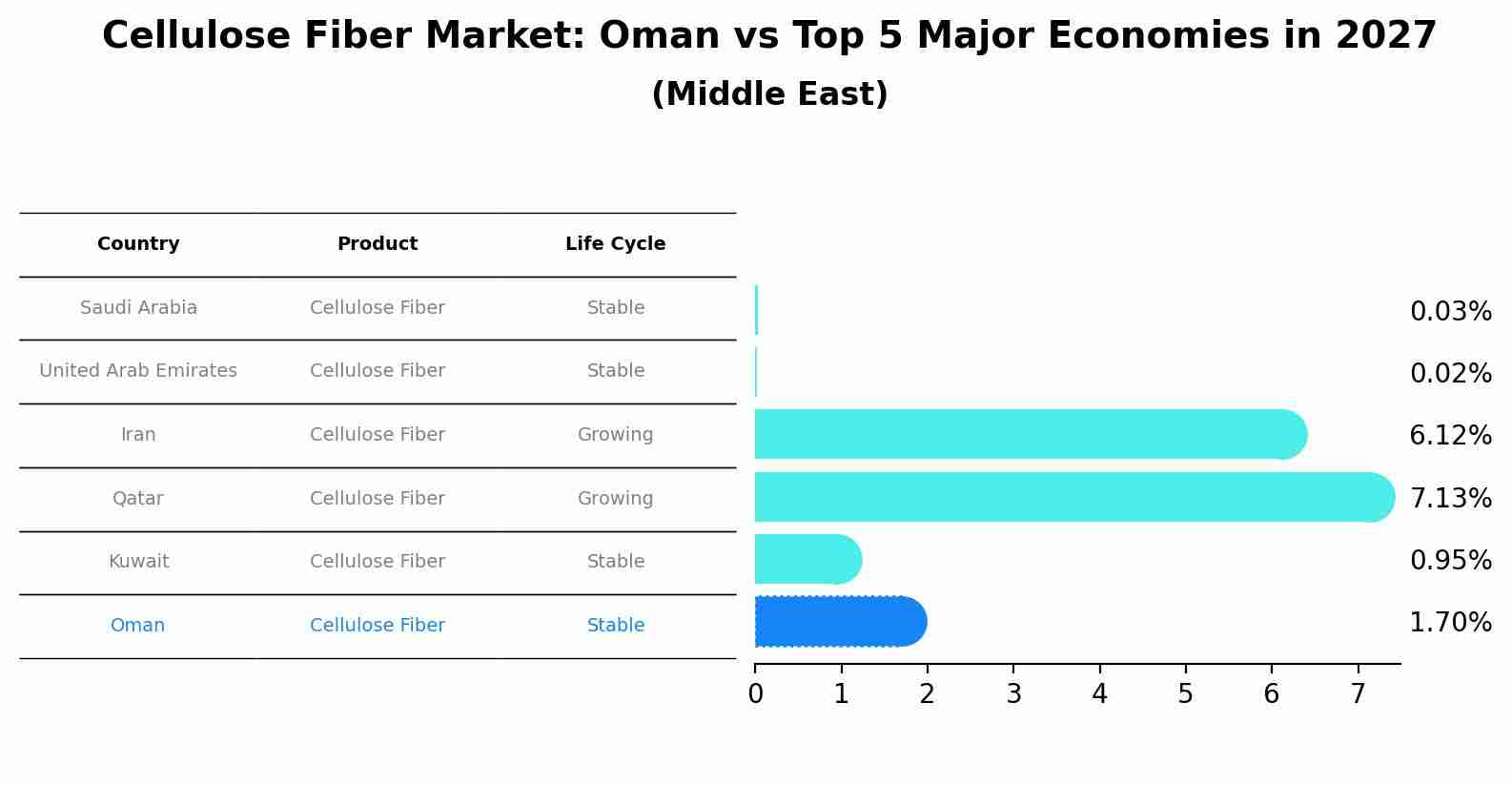Oman Cellulose Fiber Market Outlook | Growth, Forecast, Size, Share, Industry, Companies, Revenue, Value, Analysis, COVID-19 IMPACT & Trends
| Product Code: ETC251143 | Publication Date: Aug 2022 | Updated Date: Aug 2025 | Product Type: Market Research Report | |
| Publisher: 6Wresearch | Author: Ravi Bhandari | No. of Pages: 75 | No. of Figures: 35 | No. of Tables: 20 |
Oman Cellulose Fiber Market Size Growth Rate
The Oman Cellulose Fiber Market is projected to witness mixed growth rate patterns during 2025 to 2029. Commencing at 1.35% in 2025, growth builds up to 2.06% by 2029.

Cellulose Fiber Market: Oman vs Top 5 Major Economies in 2027 (Middle East)
The Cellulose Fiber market in Oman is projected to grow at a stable growth rate of 1.70% by 2027, highlighting the country's increasing focus on advanced technologies within the Middle East region, where Saudi Arabia holds the dominant position, followed closely by United Arab Emirates, Iran, Qatar and Kuwait, shaping overall regional demand.

Oman Cellulose Fiber Market Overview
The cellulose fiber market in Oman is experiencing growth driven by the rising demand for sustainable and eco-friendly fibers in the textile and nonwoven industries. Cellulose fibers, derived from renewable sources such as wood pulp and cotton, offer properties such as breathability, moisture absorption, and biodegradability, making them ideal for various applications. With increasing consumer awareness of environmental sustainability and regulations promoting green materials, the demand for cellulose fibers is expected to escalate in Oman, prompting manufacturers to expand production capacities and develop innovative fiber technologies.
Drivers of the market
The demand for cellulose fibers in Oman is driven by factors such as the increasing awareness regarding sustainable and eco-friendly materials, coupled with the growing demand for textiles and paper products. Additionally, the versatility of cellulose fibers in various applications such as clothing, hygiene products, and packaging further contributes to market growth.
Challenges of the market
In the Oman cellulose fiber market, challenges revolve around sustainable sourcing practices and technological advancements in fiber production processes. Manufacturers must navigate environmental concerns and regulatory requirements for forest management to ensure the responsible sourcing of cellulose fibers. Additionally, optimizing manufacturing processes to enhance fiber properties such as strength, durability, and moisture resistance poses challenges for meeting diverse market demands across industries such as textiles, paper, and composites.
Government Policy of the market
In Oman, the government may implement policies and initiatives to support the growth of the cellulose fiber market, which is used in industries such as textiles, paper, and automotive. These policies may include investment in research and development to improve production technologies and product performance, as well as incentives for businesses to adopt sustainable and environmentally friendly practices. Additionally, government support for industries that rely on cellulose fiber, such as textile manufacturing and packaging, may indirectly influence market demand through infrastructure investment and economic development initiatives.
Key Highlights of the Report:
- Oman Cellulose Fiber Market Outlook
- Market Size of Oman Cellulose Fiber Market, 2024
- Forecast of Oman Cellulose Fiber Market, 2031
- Historical Data and Forecast of Oman Cellulose Fiber Revenues & Volume for the Period 2018 - 2031
- Oman Cellulose Fiber Market Trend Evolution
- Oman Cellulose Fiber Market Drivers and Challenges
- Oman Cellulose Fiber Price Trends
- Oman Cellulose Fiber Porter's Five Forces
- Oman Cellulose Fiber Industry Life Cycle
- Historical Data and Forecast of Oman Cellulose Fiber Market Revenues & Volume By Fiber Type for the Period 2018 - 2031
- Historical Data and Forecast of Oman Cellulose Fiber Market Revenues & Volume By Introduction for the Period 2018 - 2031
- Historical Data and Forecast of Oman Cellulose Fiber Market Revenues & Volume By Natural Cellulose Fibers for the Period 2018 - 2031
- Historical Data and Forecast of Oman Cellulose Fiber Market Revenues & Volume By Man-made Cellulose Fibers for the Period 2018 - 2031
- Historical Data and Forecast of Oman Cellulose Fiber Market Revenues & Volume By Others for the Period 2018 - 2031
- Historical Data and Forecast of Oman Cellulose Fiber Market Revenues & Volume By Applications for the Period 2018 - 2031
- Historical Data and Forecast of Oman Cellulose Fiber Market Revenues & Volume By Introduction for the Period 2018 - 2031
- Historical Data and Forecast of Oman Cellulose Fiber Market Revenues & Volume By Apparel for the Period 2018 - 2031
- Historical Data and Forecast of Oman Cellulose Fiber Market Revenues & Volume By Home Textile for the Period 2018 - 2031
- Historical Data and Forecast of Oman Cellulose Fiber Market Revenues & Volume By Industrial for the Period 2018 - 2031
- Historical Data and Forecast of Oman Cellulose Fiber Market Revenues & Volume By Others for the Period 2018 - 2031
- Oman Cellulose Fiber Import Export Trade Statistics
- Market Opportunity Assessment By Fiber Type
- Market Opportunity Assessment By Applications
- Oman Cellulose Fiber Top Companies Market Share
- Oman Cellulose Fiber Competitive Benchmarking By Technical and Operational Parameters
- Oman Cellulose Fiber Company Profiles
- Oman Cellulose Fiber Key Strategic Recommendations
Frequently Asked Questions About the Market Study (FAQs):
1 Executive Summary |
2 Introduction |
2.1 Key Highlights of the Report |
2.2 Report Description |
2.3 Market Scope & Segmentation |
2.4 Research Methodology |
2.5 Assumptions |
3 Oman Cellulose Fiber Market Overview |
3.1 Oman Country Macro Economic Indicators |
3.2 Oman Cellulose Fiber Market Revenues & Volume, 2021 & 2031F |
3.3 Oman Cellulose Fiber Market - Industry Life Cycle |
3.4 Oman Cellulose Fiber Market - Porter's Five Forces |
3.5 Oman Cellulose Fiber Market Revenues & Volume Share, By Fiber Type, 2021 & 2031F |
3.6 Oman Cellulose Fiber Market Revenues & Volume Share, By Applications, 2021 & 2031F |
4 Oman Cellulose Fiber Market Dynamics |
4.1 Impact Analysis |
4.2 Market Drivers |
4.2.1 Increasing demand for sustainable and eco-friendly materials in various industries. |
4.2.2 Growing awareness about the environmental benefits of cellulose fibers. |
4.2.3 Favorable government regulations promoting the use of cellulose fibers in Oman. |
4.3 Market Restraints |
4.3.1 Fluctuating prices of raw materials used in cellulose fiber production. |
4.3.2 Intense competition from synthetic fibers in the market. |
4.3.3 Limited technological advancements in cellulose fiber production processes. |
5 Oman Cellulose Fiber Market Trends |
6 Oman Cellulose Fiber Market, By Types |
6.1 Oman Cellulose Fiber Market, By Fiber Type |
6.1.1 Overview and Analysis |
6.1.2 Oman Cellulose Fiber Market Revenues & Volume, By Fiber Type, 2021-2031F |
6.1.3 Oman Cellulose Fiber Market Revenues & Volume, By Introduction, 2021-2031F |
6.1.4 Oman Cellulose Fiber Market Revenues & Volume, By Natural Cellulose Fibers, 2021-2031F |
6.1.5 Oman Cellulose Fiber Market Revenues & Volume, By Man-made Cellulose Fibers, 2021-2031F |
6.1.6 Oman Cellulose Fiber Market Revenues & Volume, By Others, 2021-2031F |
6.2 Oman Cellulose Fiber Market, By Applications |
6.2.1 Overview and Analysis |
6.2.2 Oman Cellulose Fiber Market Revenues & Volume, By Introduction, 2021-2031F |
6.2.3 Oman Cellulose Fiber Market Revenues & Volume, By Apparel, 2021-2031F |
6.2.4 Oman Cellulose Fiber Market Revenues & Volume, By Home Textile, 2021-2031F |
6.2.5 Oman Cellulose Fiber Market Revenues & Volume, By Industrial, 2021-2031F |
6.2.6 Oman Cellulose Fiber Market Revenues & Volume, By Others, 2021-2031F |
7 Oman Cellulose Fiber Market Import-Export Trade Statistics |
7.1 Oman Cellulose Fiber Market Export to Major Countries |
7.2 Oman Cellulose Fiber Market Imports from Major Countries |
8 Oman Cellulose Fiber Market Key Performance Indicators |
8.1 Percentage of cellulose fiber used in industries compared to other types of fibers. |
8.2 Rate of adoption of cellulose fiber-based products by consumers. |
8.3 Environmental impact assessment of cellulose fiber production processes. |
9 Oman Cellulose Fiber Market - Opportunity Assessment |
9.1 Oman Cellulose Fiber Market Opportunity Assessment, By Fiber Type, 2021 & 2031F |
9.2 Oman Cellulose Fiber Market Opportunity Assessment, By Applications, 2021 & 2031F |
10 Oman Cellulose Fiber Market - Competitive Landscape |
10.1 Oman Cellulose Fiber Market Revenue Share, By Companies, 2024 |
10.2 Oman Cellulose Fiber Market Competitive Benchmarking, By Operating and Technical Parameters |
11 Company Profiles |
12 Recommendations |
13 Disclaimer |
- Single User License$ 1,995
- Department License$ 2,400
- Site License$ 3,120
- Global License$ 3,795
Search
Thought Leadership and Analyst Meet
Our Clients
Related Reports
- Canada Oil and Gas Market (2026-2032) | Share, Segmentation, Value, Industry, Trends, Forecast, Analysis, Size & Revenue, Growth, Competitive Landscape, Outlook, Companies
- Germany Breakfast Food Market (2026-2032) | Industry, Share, Growth, Size, Companies, Value, Analysis, Revenue, Trends, Forecast & Outlook
- Australia Briquette Market (2025-2031) | Growth, Size, Revenue, Forecast, Analysis, Trends, Value, Share, Industry & Companies
- Vietnam System Integrator Market (2025-2031) | Size, Companies, Analysis, Industry, Value, Forecast, Growth, Trends, Revenue & Share
- ASEAN and Thailand Brain Health Supplements Market (2025-2031) | Strategy, Consumer Insights, Analysis, Investment Trends, Opportunities, Growth, Size, Share, Industry, Revenue, Segments, Value, Segmentation, Supply, Forecast, Restraints, Outlook, Competition, Drivers, Trends, Demand, Pricing Analysis, Competitive, Strategic Insights, Companies, Challenges
- ASEAN Bearings Market (2025-2031) | Strategy, Consumer Insights, Analysis, Investment Trends, Opportunities, Growth, Size, Share, Industry, Revenue, Segments, Value, Segmentation, Supply, Forecast, Restraints, Outlook, Competition, Drivers, Trends, Demand, Pricing Analysis, Competitive, Strategic Insights, Companies, Challenges
- Europe Flooring Market (2025-2031) | Outlook, Share, Industry, Trends, Forecast, Companies, Revenue, Size, Analysis, Growth & Value
- Saudi Arabia Manlift Market (2025-2031) | Outlook, Size, Growth, Trends, Companies, Industry, Revenue, Value, Share, Forecast & Analysis
- Uganda Excavator, Crane, and Wheel Loaders Market (2025-2031) | Strategy, Consumer Insights, Analysis, Investment Trends, Opportunities, Growth, Size, Share, Industry, Revenue, Segments, Value, Segmentation, Supply, Forecast, Restraints, Outlook, Competition, Drivers, Trends, Demand, Pricing Analysis, Competitive, Strategic Insights, Companies, Challenges
- Rwanda Excavator, Crane, and Wheel Loaders Market (2025-2031) | Strategy, Consumer Insights, Analysis, Investment Trends, Opportunities, Growth, Size, Share, Industry, Revenue, Segments, Value, Segmentation, Supply, Forecast, Restraints, Outlook, Competition, Drivers, Trends, Demand, Pricing Analysis, Competitive, Strategic Insights, Companies, Challenges
Industry Events and Analyst Meet
Whitepaper
- Middle East & Africa Commercial Security Market Click here to view more.
- Middle East & Africa Fire Safety Systems & Equipment Market Click here to view more.
- GCC Drone Market Click here to view more.
- Middle East Lighting Fixture Market Click here to view more.
- GCC Physical & Perimeter Security Market Click here to view more.
6WResearch In News
- Doha a strategic location for EV manufacturing hub: IPA Qatar
- Demand for luxury TVs surging in the GCC, says Samsung
- Empowering Growth: The Thriving Journey of Bangladesh’s Cable Industry
- Demand for luxury TVs surging in the GCC, says Samsung
- Video call with a traditional healer? Once unthinkable, it’s now common in South Africa
- Intelligent Buildings To Smooth GCC’s Path To Net Zero


















